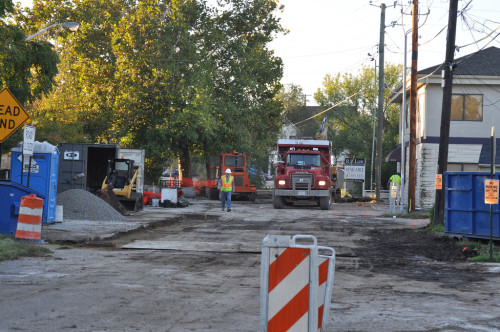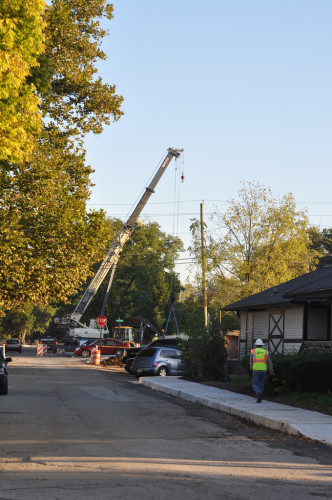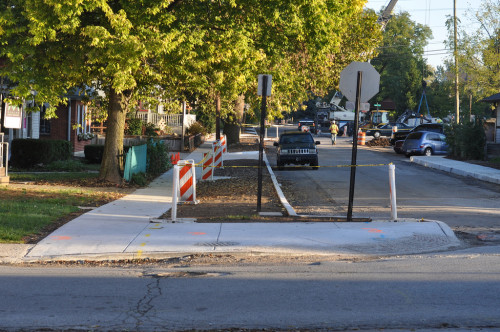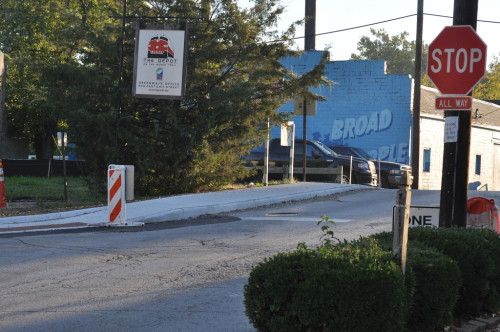Back in June, Urban Indy reported that Cornell Ave, located north of the central canal in Broad Ripple Village, would be the location of a project to resurface the street, streamline the pedestrian right of ways and create reverse angle parking areas near the Broad Ripple Brewpub.

As of early October, significant progress has been made towards completing this project. Sidewalks have been poured providing a new pedestrian access point directly from the Monon where none existed prior. Additionally, new curbs and sidewalks along Cornell Ave are in place while work continues along the corridor.

As you can see from the photos, the pedestrian experience should be significantly improved once this project is completed. Bump-outs are now present at 64th & Cornell inducing a much slower automobile environment. New angle in parking spaces have been added near the old depot where Public Greens will be opening (sometime soon?).

While this project provides significant improvements for the pedestrian, motorists will enjoy the increased number of parking spaces further north on Cornell. The right of way has been widened all the way to the Indianapolis Art Center providing some relief for what can be a very busy area during the warm months when significant automobile congestion can be an issue from all the visitors to restaurants.

Taken as a whole, the increased number of parking spaces should cut down on traffic circulation due to lack of parking spaces, providing a safer experience for pedestrians. Stay tuned for additional photos as this project nears completion.
What is that space between the sidewalk and the curb? Never seen one of those before…
I think it was an accident. Should be paved over soon. 🙂
Rest assured, that space is only there because someone “mistakenly” designed it that way decades ago. It wasn’t some wide eyed plan to change the status quo.
Snow storage area. 🙂
Thanks for posting the news, since Cornell was an important street to avoid some Broad Ripple congestion, but I’m deeply saddened to see that they’ve ruined Cornell, at least for a while.
“While this project provides significant improvements for the pedestrian, motorists will enjoy the increased number of parking spaces further north on Cornell.”
Pedestrians can use the Monon, and motorists always enjoy more lanes, higher speeds and less interference with speedy operation.
Those “bump outs” are an irresponsible and dangerous attack on car travel. These attacks on cars are going to diminish Indy’s ability to compete with other cities. Companies will be forced to look at other cities that are more serious about swiftly moving their motorists.
Some day, a future administration that’s grounded in reality will have to spend about a week roaming Broad Ripple with a bulldozer and jackhammer removing the impediments to car travel that have been foolishly erected in the past few years.
thank you sad for the entertaining read. i always appreciate unthoughtful nonsense!
It’s a math problem, Stout. I’m guessing we don’t share the same views on gay marriage, but roads are hard engineering designed to do a single mission as quickly as possible.
There simply isn’t a tender, thoughtful, inclusive, tolerant way to flow more cars.
sad, you are absolutely correct. If one’s primary goal is to “flow more cars”, adding capacity and streamlining the right of way to support that is the best way to do that.
However, I challenge you to show me where that is the primary goal of the Broad Ripple Village. According to the Envision Broad Ripple plan, Broad Ripple will be anything but a place where flowing a large amount of cars as quickly as possible is a primary or even secondary goal. Utilizing complete streets design standards coupled with improved walkability, storm water drainage and the addition of street-side curbs will foster an environment of multi-modal transportation options.
Indeed, the “Streets” section of the plan prioritizes transportation in the following hierarchy:
1 – Pedestrians
2 – Public Transit
3 – Bicycles
4 – automobiles
Furthermore, improving traffic circulation IS a mention in the plan however, College Ave is the only corridor which receives a mention as an artery. The rest of the streets are encouraged as multi-modal opportunities for transportation.
My conclusions about the angle in parking are therefore, not totally off base as they do represent a focused increase in capacity in a micro area which sees higher amounts of automobile activity in the warmer months because so many people want to come visit the fine establishments, not cruise through as fast as possible.
This might be a strange observation, but I have noticed a difference in projects similar to this when the concrete curb extends flat approx. 1 foot into the street, creating an even separation of the curb from the asphalt road surface. It is not the case here (from what i can see in the photos), where the asphalt meets the curb at the point where rain water would typically collect and be routed to the nearest drainage point.
Can someone explain if this difference is likely a cost-cutting measure? Does is really matter if you have a concrete curb for water flow versus the concrete/asphalt combination?
Well, I’m no engineer, but I do know that the City ordinance instructs that a one-foot concrete gutter is to be included with the curb along all City streets (Sec 691-169). Obviously, the City very rarely ever meets this code. I’ve always thought that it looks better and presumed that it provided for better storm water flow. The concrete gutter also seems to be much less prone to having weeds grow in the street, since there isn’t a seam right at the edge of curb. I presume that if any weeds were to grow out of a seam that is one foot into the street, they would be promptly annihilated by the crushing weight of vehicle tires.
And, BTW, Sad’s comments are just that.
You are correct. Having the 1 foot concrete curb gutter makes for a much better design all around. For one, it just holds up better since typically cars aren’t driving on it (assuming the driving/parking lane is built wide enough). And as long as the city doesn’t ever pave over it (a horrible and lazy move in my opinion), it will continue to function well. It is a much more precise design with a slight angle away from the street which carries water to the drains better. DPW never seems to get the angle of the asphalt correct when repaving a road, and this prevents that problem. I really wish that Indy’s road crew would go study other cities that have had design points like this solved for decades.
I live in this area and it is not an appropriate cut through to avoid Broad Ripple congestion. People do cut through all the time and the streets are narrow and the pedestrian use is high. This not a safe combination and honestly even if the city wanted to increase capacity (which would ruin the area as it is a side street that doesn’t exactly go anywhere) they probably couldn’t as that is the way the area was built long ago. I hope that Sad lives in Fishers and the city comes into his sub division and puts banked turns in to handle 70 MPH speeds and calls it an appropriate 69 by pass.
“However, I challenge you to show me where that is the primary goal of the Broad Ripple Village.”
There is no Broad Ripple “Village.” It’s a neighborhood of the City of Indianapolis. City streets are supposed the flow the most amount of cars, given the rank of the road, as quickly and as easily as possible.
“According to the Envision Broad Ripple plan, Broad Ripple will be anything but a place where flowing a large amount of cars as quickly as possible is a primary or even secondary goal.”
Means nothing. Those are City streets, not private playthings.
Streets means cars; cars means fast. Further, it’s dangerous foolishness to encourage cars to use anything but the most lightly traveled side street. These painted on “bike lanes” that steal the second traffic lane are going to get bicyclists killed.
Or, everyone of influence and means will move to Carmel where the roads are practical and fairly well designed.
This is a small old side street that has lots and lots of pedestrians on it and travels for about a half mile. I just do not think you have a case here. No one is “calming” College Avenue here. Streets serve more of a purpose than just cars. It is a neighborhood side street not a main artery. Do you think subdivisions should allow for 50mph speeds? They have wide streets and sometimes offer nice cut throughs……or is this a danger to people? Streets need to be traveled and CROSSED by other things than cars and this needs to be taken into account. The fact is this is an old street that was built long ago. The width and building placement along with how it interacts with other streets just do not allow it to be a fast traveling street besides all the other reasons……unfortunatley your engineering expertise most likely wasn’t available at the time.
We should probably stop feeding the troll.
“No one is “calming†College Avenue here.”
Been North of 71st, lately? Instead of widening College to, at least, two lanes northbound all the way to 96th, they’re cutting off the right side of the road and adding some sort of non-car use.
Ahow, are you so disconnected from reality that you think it’s “trolling” to want roads to serve the almighty car? How much do you drive in a day, son?
You come into a group of people who prefer one thing (more pedestrian and bike infrastructure, less devotion to the the automobile) and spout the exact opposite without offering any sort of reason beyond your opinion. It’s trolling.
I drive minimally. I work from home and we live within a mile of my wife’s work. I bike the kids home from school a couple days per week and take the bus the other couple of days. We walk quite a bit too. We have specifically chosen to live our lives so we can drive the least amount possible.
But here is the thing, I do drive, so I would never advocate getting rid of roads and car infrastructure. I would prefer that we offer choice in the matter instead of coercing car ownership. So far, Indy’s evolution over the past century has been anything but balanced. However, that tide is starting to change and I appreciate that.
If you want anyone here to take you seriously, try not using inflammatory phrases like “almighty car.” Instead, how about engaging in a discussion about how all users might be included in transportation planning in Indy. Don’t forget that “all users” includes people who physically unable to drive and people who can’t afford $10,000 per year to drive.
You know, it really doesn’t cost most middle-class people $10,000 a year to own a car and drive, and inflated numbers like that will “feed the troll”. Yes, if you buy a new Beemer or Benzer every couple of years, it’ll cost you that much. But only a few people do that.
I recently bought a good used car. It costs me about $800 to insure it, $100 for plates, about $2400 for gasoline annually, and probably another $1200 for maintenance if I don’t run it into anything immovable. I will probably drive that car 6 years or so. Even if it’s worthless in 6 years (probably not the case), my annual average cost will be just barely over half the $10K you quoted, around $5200 (plate and insurance costs will go down some with age).
That’s about $100/week; at the Indy-area median household income of about $52K, about 10% to car/mobility. Mine is a low-end budget, but it’s possible and practical and necessary in a city where transit is not a good or reliable option outside a few well-served areas.
You know, it really doesn’t cost most middle-class people $10,000 a year to own a car and drive, and inflated numbers like that will “feed the trollâ€.
Thank you for your anecdotal experience on what you spend per year on your car. However, that has little bearing on what the median person spends on their vehicle.
The median cost of car ownership (coming from a pro-car place like the AAA, no less) is $9,151. That means half the people that own a mid-sized sedan and drive 15,000 miles a year would pay more than that, half would pay less. Assuming you live inside 465, that seems about right that you pay less since you probably drive less than 15,000 per year.
http://exchange.aaa.com/wp-content/uploads/2013/04/Your-Driving-Costs-2013.pdf
Again, please cite good stats. The median miles driven is between 9,000 and 9,500, not 15,000. The secondary source of this information is: http://dc.streetsblog.org/2013/02/27/for-eighth-year-in-a-row-the-average-american-drove-fewer-miles-in-2012/ but this tracks with the St. Louis Fed’s VMT stats overall.
I cited my personal anecdote because I’m pretty close to (and thus illustrate) the median driver, both in miles driven and in vehicle age: I drive an older car less than 10,000 miles per year.
Other supporting evidence: the IRS’s 55.5 cents per mile cost estimate (which is what they allow as a deduction for business use) is also close to my anecdotal report.
So…using government numbers, the median driver driving 9,250 miles per year at 55.5 cents per mile, spends $5,133.75 per year on car transportation. What I said. $100/week.
Again, don’t play into the hands of those who see Urban Indy hosts and contributors as anti-car, by repeating overblown and demonstrably false “statistics” about auto costs. Of course AAA wants you to think people drive more than they really do. They advocate for roads, towing services, insurance, and car travel generally.
I didn’t see the annual median forl miles driven, but the average miles driven by an individual in the U.S. as of April, 2011 was 13,476, according to the Federal Highway Administration. The difference between the annual average and median miles driven tends to be larger primarily when considering elder drivers, and it is much less substantial for most other age groups, so I think it is fine to use that average. Also, the current IRS reimbursement rate is now 56.5 cents per mile.
In any event, the bottom line is that in most cases it is significantly more costly to own a car than it is to use alternative transportation methods, including public transportation.
Also, this person going off about the Cornell Ave. redesign isn’t concerned about the cost of a car versus other means of travel. He/she is upset about the reduced traffic flow, which is the intended effect of the redesign.
Sorry, back to Cornell. I’m no expert at engineering or street infrastructure…but given this area of BRV, it seems to make sense to upgrade the street infrastructure to better support both pedestrians and vehicles. I guess I can’t really elaborate too much more about this?
Upgrade is hardly the word, I’d call it basic maintenance. That “street” was in horrible condition before this project. It was practically one big pothole with zero drainage. It’s good to see the city doing the basics to a very heavily used street by both cars and pedestrians. I really wish that Indy had a much more distributed way of doing road maintenance, repair and improvement and that it didn’t all have to go through one DPW. Marion county is gigantic, it’s amazing that DPW can keep up with anything at all.
Agreed. There is a bike-ped trail right next to this street, and lots of people drive to BR in order to use it. They have to park somewhere and Cornell is a good place.
It doesn’t seem “anti-car” to use street pavement for cars to park on.
“You come into a group of people who prefer one thing (more pedestrian and bike infrastructure, less devotion to the the automobile) and spout the exact opposite without offering any sort of reason beyond your opinion. It’s trolling.”
So “trolling” equals precisely “departure from groupthink?” Do you post here as a shelter from other places where your comments would be risible?
The purpose of any discussion, regardless of locus, is to conduct it honestly.
Your pedestrian-biased, anti-car viewpoint is such a staggering minority that you’d be lucky to find one person who agreed with you in a normal cross-section of America, say the entire Fishers Wal-Mart.
Lastly, I have no idea how biased or skewed the viewpoint is here. I saw a link on someone else’s page.
“Instead, how about engaging in a discussion about how all users might be included in transportation planning in Indy.[sic]”
I don’t believe in that, not in any sort of equal weighting. Cars come first. Everything else is an accommodation. It’s nice to have a bike trail in a park, but not an inch of road should be sacrificed to make a path for bicycles.
So many Indy roads have not kept up with progress. Allisonville, Westfield, Fall Creek, College are all in need of a massive widening. We need more lanes, not less, and we need faster speed limits that come with wider roads. More lanes, more strip malls, more interstates, more shopping, more parking lots.
Take a look at Hamilton Town Center for a place that’s doing great. That’s what people want. Big shopping by a big Interstate. Go to Easton in Columbus. By contrast, everyone thinks Broad Ripple Avenue is a disaster.
Comments have been closed on this article due to the conversation veering off course.